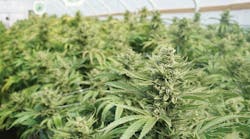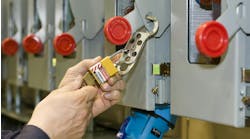Daniel Gustafik chuckles when he remembers the simplicity of the first marijuana grow house he wired nearly 20 years ago. It was 1997, one year after California Proposition 215 legalized the cultivation and use of pot for medicinal use, and the wife of one of Gustafik’s friends was one of the state’s first residents to qualify for the legal exemption.
“Hey, you know how to do these electrical things,” the friend said to him one day, as the pair discussed the small grow he was planning. “Help me figure out how to make this work.”
Gustafik agreed, and the pair rigged up a system that included non-metallic sheathed cable, fluorescent lights, and hot water heater timers. It got the job done — barely — but the systems he designs and installs now with his firm, Hybrid Tech, are just slightly more sophisticated.
“Now we’re doing pretty standard installations that you would recognize in any industrial facility,” says Gustafik. “You’re looking at trapeze lighting and under-slab conduits. You’re looking at PLC control panels for all of your irrigation protocol and your lighting protocol.”
In other words, it’s a brand new day for the electrical systems that serve marijuana grows (Photo 1) and other indoor agricultural installations. And the lighting industry is taking notice. In March 2016, market research firm MarketsandMarkets released an analysis that forecasts a doubling in demand for grow lights worldwide between 2016 and 2022, with sales approaching $4.2 billion by the end of that period. More than half of that growth is expected to take place in North America.
“The demand is — and will be — strong all over the United States,” says Ravindra Puranik, a MarketsandMarkets research analyst. “And there’s no particular region where it’s growing more.”
Gustafik’s success over even just the last few years speaks to the market’s explosive evolution. Hybrid Tech is based in Portland, Ore., and much of its work has been focused there since 2014, when the state legalized marijuana for recreational use. But two decades in the business has helped him develop a client base across the country. Currently, Gustafik has projects in California, Washington, Nevada, Illinois, Maryland, Maine, Hawaii, New York, and Colorado. “We’re definitely in boom mode,” he says.
It seems the rest of the industry isn’t far behind.
Cultivating demand
The Drug Enforcement Administration’s (DEA’s) recent reaffirmation of marijuana as a Class 1 controlled substance notwithstanding, the drug’s domestic production has never been higher. Four states have legalized recreational production and use, and more than 20 have either decriminalized it or approved it to varying degrees for medicinal use. The production of that pot is what MarketsandMarkets says is driving the majority of demand for grow lights in the United States.
“In the U.S., the cannabis industry is very big — much more so than in other countries, such as Europe and Japan,” Puranik says. “And that is a big influence on the grow light market.”
But that’s only part of the story. In the last decade, farming operations across the country have begun moving indoors.
“The need for fresh fruits and vegetables is absolutely proving to be a factor in the growth of LED lights,” says Puranik says.
Unlike traditional greenhouses, though, these new installations are growing up in addition to out (Photo 2). Vertical farms are just what they sound like: one layer of plants stacked upon another in a controlled environment. Those crops — typically low-profile greens like lettuce, basil, and kale — can be grown year round, require no soil, and never see the sun. Obviously that last characteristic makes lighting necessary in these farms, but it’s the vertical nature that makes so much lighting necessary. Each layer requires its own lamps; a vertical farm with four layers of plants effectively quadruples the demand.
“You can see how quickly things can scale,” says Howard Brin, the chief operating officer of the Association for Vertical Farming.
Yet until recently, those lights — the very things capable of keeping crops alive indoors — were paradoxically stunting the industry’s growth. HPS lamps gave off too much heat; not only would they have to be several feet from the plants below them, but they’d also have to be separated from the plants above so as to not cook the roots. As a result, vertical density suffered. (So did HVAC bills; even if the plants received adequate separation, ambient temperature in the buildings themselves would make tending the crops unpleasant.)
And while much cooler, fluorescent tubes just weren’t energy efficient. When you’re paying for your sunlight, you don’t want to have to pay top dollar. Enter the LED: cool, energy-efficient, capable of a wide variety of spectral compositions, and dimmable. Yes, dimming is beneficial for indoor agriculture applications — but not because plants need mood lighting. Dimmable lights allow for real-time reactive lighting grids in daylight harvesting systems, particularly in more advanced greenhouse systems.
“Let’s say you’ve got full sun, and the daylight harvesting sensors shut down the lighting grid,” says Gustafik. “Now we have cloud cover, so let’s turn on our supplemental lighting grids. Well, with an HPS light, we’d have a delay of about 10 minutes. You can’t toggle them on and off repeatedly.”
Perhaps most important, though, LEDs are also quite a bit more affordable than other options. In early 2015, manufacturers began producing much more cost-effective options specifically for agricultural use, and just like that, the vertical farming industry was poised for significant growth — well, eventually.
“You’re starting to see a lot of these companies — after 18 months of testing — beginning to scale up to their first commercial operations,” Brin says. “But it’s still a very small industry.”
Coming up green
There’s reason to believe demand will increase. But like any new concept, there are complications. Public awareness is one. “There’s a huge drive for organic and locally produced food, and vertical farms fit into that space,” Brin says. “But for some people, it’s strange to think that your food is being grown in a warehouse without natural sunlight or soil.”
Local laws will likely play a part. Urban centers are prime real estate for vertical farms, with both plenty of warehouse space and educated consumers in search of locally sourced produce. But many municipalities have been slow to adopt zoning conducive to agriculture.
“You might have a building where someone wants to use one floor for vertical farming and another for residential. That’s not allowed in a lot of cities,” Brin says. “There’s a lot of gray area because it’s such a new industry.”
The city of Atlanta, though, has taken the lead on the issue. In October 2015, it named Mario Cambardella its urban agriculture director — one of the first such positions in the country.
But the biggest obstacle standing in the way of the vertical farming industry — and by extension, the growth of the grow light market — may be the complexity of the farms themselves.
“The early adopters that are jumping into the space now are going to be the ones that uncover all of the wrinkles that need to be ironed out to make this a truly viable option,” says Travis Williams, the director of marketing for Fluence Bioengineering.
One of those wrinkles is the issue of microclimates. Heat rises. So, depending on how tall a vertical farm is, the temperature on the top layer of plants could be significantly higher than the first layer. And when you’re dealing with plants that require very specific conditions for maximizing yield, even a difference of a few degrees can throw off that delicate balance.
“That’s why energy efficiency is so vital to controlling that environment,” Williams says. “The less heat you have to dissipate and manage, the better it’s going to be for your crop.”
Then there’s relative humidity. Leave the lights on for 12 hours, and the heat will increase — even when you’re dealing with LEDs. Turn those lights off, and the temperature drops rapidly, which is a problem for indoor plants.
“And if you don’t have an HVAC system or a control system that can account for that,” Williams says, “you can get mildew or other negative side effects as a consequence of that.”
There are also NEC issues to contend with.
“You have a water source above a fixture with a double-stack canopy, so you obviously have to have a fixture that is IP66-rated or the entire thing is illegal,” Gustafik says. “Everything else, of course, has to be wet-location approved below because you have irrigation occurring constantly on the layer above.”
The other side of those complications, though, is the degree to which lights can be designed and used to maximize yield. In scientific terms, it’s called photomorphogenesis. For example, marijuana plants in their initial growth phase — the vegetative stage — do better under blue light. On the other hand, red light will encourage those same plants to enter their flowering stage, when they produce the “buds” that will eventually be sold. Want a shorter plant and therefore allow for more layers? Cut the blue light off earlier in the growth cycle and shift to red. Those same principles can be applied to more mainstream produce.
Therein lies the paradox of indoor farming: Virtually every condition and variable — particularly lighting — is controllable. This is a good thing if you know what you’re doing; but if you don’t, it can be disastrous.
“People see the potential of vertical farming and invest a tremendous amount of capital without understanding the nuances of the engineering and electrical needs,” Williams says. “But you only get one opportunity to build out a low-cost operating facility that’s going to do what it needs to do.”
Gustafik has seen his fair share of lighting systems that were designed poorly, in large part because he’s called in to fix them. Washington and Colorado — the first two states in the country to legalize pot for recreational use — are the biggest offenders.
“All of the projects we’re working on in those states are repairs,” he says. “The established markets are in much more of a ‘let’s fix this’ mode right now.”
The knowledge necessary to correct those problems was hard won. For the first 15 years he worked in the industry, Gustafik learned as he went. White papers that spelled out the thermal load calculations for and the transpiration and perspiration rates of all kinds of plants abounded. So designing a lighting system to meet those needs was a matter of plugging a few numbers into a formula. But with marijuana, Gustafik’s crew was starting from scratch. Legitimate botanists didn’t want to go anywhere near that space, and those who did had no interest in sharing the knowledge they’d accumulated.
“We’ve literally had to datalog everything internally,” says Gustafik, who admits it took a lot of work but also wasn’t necessarily all bad. “In the end, that gave us a lot of intellectual property that very few people in the entire world have.”
Sunny skies ahead
The bottom line is the grow light market is poised for — pardon the pun — serious growth. From a macro sense, consider Moore’s Law: The decade’s old theory posits that the number of transistors that can fit on a circuit doubles every year. And that’s why we’ve seen computers get smaller, while simultaneously getting more powerful, for the last two decades. LEDs appear to be on that same trajectory.
“You’re starting to see that same rapid improvement,” Williams says. “And with that rapid improvement, you’re also seeing a dramatic drop in price.”
On a smaller scale, the market that’s using those grow lights is only going to get more competitive. With marijuana legalization spreading — albeit at a slow and steady rate — more players are entering the industry. And while those who partook in the past used to be willing to settle for less-than-stellar product, today’s consumer expects a higher grade. This is keeping Gustafik and other installers like him busy.
“For the first time ever, our clients are willing to pay for higher quality installations,” he says. “That’s what makes the industry so exciting right now. There’s so much to do.”
Halverson is a contributing writer based in Seattle. He can be reached at [email protected].





